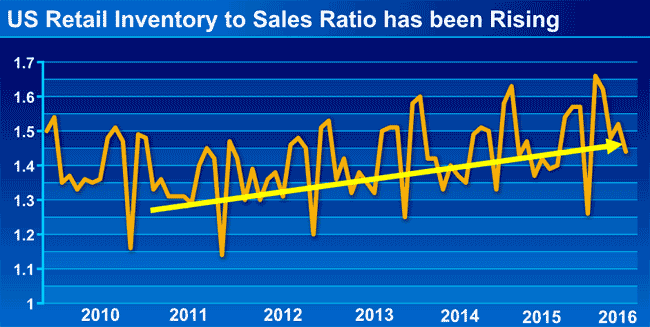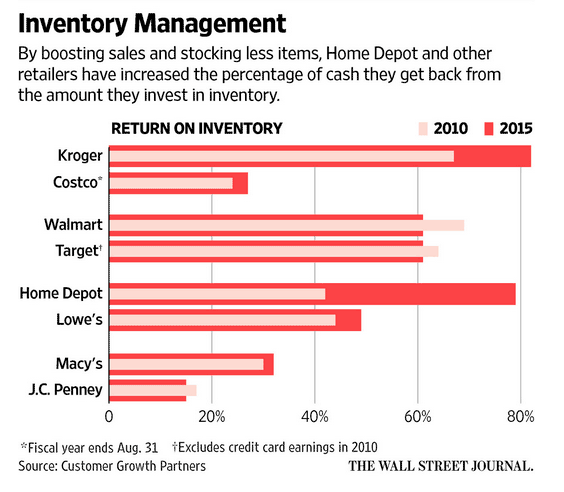Are we starting to see new thinking in retail relative to inventory levels?
Supply Chain Digest Says... |
 |
| Target stores announced earlier this year it was replacing its existing forecasting and replenishment software with in-house developed applications to manage the complexity of inventory deployment and fulfillment across its omnichannel network. |
 |
|
|
The reality is that somewhat under the radar, retail inventories have been rising. The inventory-to-sales (ITS) ratio measures the amount of inventory held as a percentage of one month's worth of sales.
As can be seen in the chart below, while the retail ITS is highly seasonal, the trend since 2010 is definitely up.
Now, some stores are once again trying to slay the inventory beast.

Source: SCDigest from Census Bureau Data
For example, Tom Shortt, Home Depot's senior vice president of supply chain told the Wall Street Journal his new message to the stores is "Get comfortable with days of inventory, not weeks." The retailer is targeting sales growth of nearly 15% by 2018, but wants to keep inventory levels flat or slightly down - quite an accomplishment versus how retail has historically managed sales growth and inventories.
Visit the Retail Vendor Performance Management home page to learn more
and subscribe to the monthly newsletter.
It is a shift happening across the retail sector, as companies try to figure out ways to profitably serve the growing needs of on-line shoppers while making their networks of brick and mortar outlets generate more cash.
"Chains must predict whether demand will come from the internet or a store visit, and whether they'll ship online orders from a distribution center or a store," the Wall Street Journal noted. "Every move of inventory is an added cost that eats away at already thin margins."
As we reported in the Retail Vendor Performance Bulletin recently, Target stores announced earlier this year it was replacing its existing forecasting and replenishment software with in-house developed applications to manage the complexity of inventory deployment and fulfillment across its omnichannel network. (See Target Stores Rethinks Inventory Management, Writes own Apps to Better Leverage Extended Supply Chain in Omnichannel World.)
Walmart and Target have been cutting back on the number of packs of diapers, boxes of cereal, and bottles of laundry detergent in their backrooms, and moving the product to shelves faster. Walmart has also widened aisles to further reduce the amount of goods on its shelves, while Target has moved bulky items such as patio furniture into centralized distribution locations instead of keeping them in stores. Kohl's Corp. is targeting inventory reductions of 10% by the end of next year, after seeing it swell 15% over the past five years as the department-store chain tried to become a bigger on-line player.
In the first quarter, Walmart's inventory rose slower than sales, helping to improve gross profit margins. "It's like oxygen in the store," CEO Doug McMillon said at the company's annual meeting last month. "The weight of inventory has been relieved to an extent. And I think that bodes well for the future."
By one measure at least, the attention on inventories seems to be working. The Wall Street Journal article included the chart below, which shows changes in what it calls "return on inventory." It's not clear how the measure is calculated, but it could be simply profits divided by inventory levels. It does not appear to be the "gross margin return on inventory" metric many retailers use.

Of course, in a more Lean retail world in terms of inventory, that puts all the more pressure on retail vendor performance management in terms of on-time delivery, fill rates, reducing "problem shipments" that delay goods to the story and more, elevating the role of vendor compliance manager.
Any comment on this article? Enter below.
Your Comments/Feedback
|
|
Mike
Manager, Expeditors International |
Posted on: Jul, 26 2016 |
|
This article makes no sense when you take into account these two sentences - "By one measure at least, the attention on inventories seems to be working." and "It's not clear how the measure is calculated". Why even publish this article?
Editor’s Note:
Well, the WSJ article did show some improvements in a measure it called “Return on Inventory” for different retailers – that’s how you get the first part. But, they did not detail how exactly how those numbers were calculated, which is how you get the second part.
We wish they would have made that clear, but we thought the chart was worth showing even without knowing exactly how the metric was defined. |
|
|